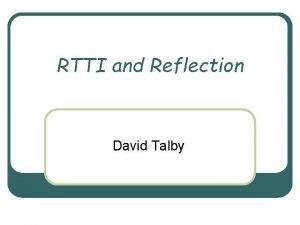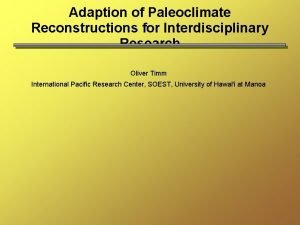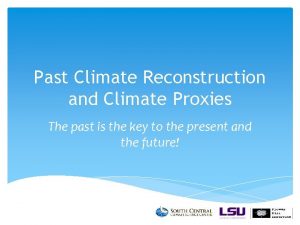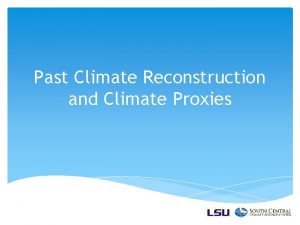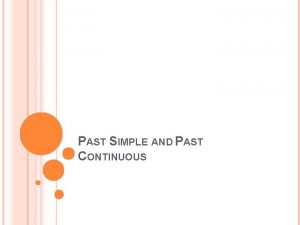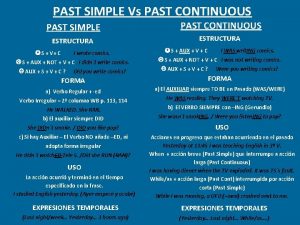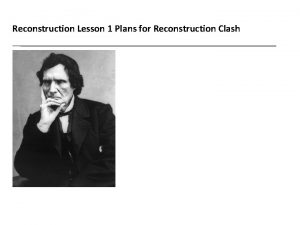Past Climate Reconstruction and Climate Proxies Note This













- Slides: 13

Past Climate Reconstruction and Climate Proxies

Note: This slide set is one of several that were presented at climate training workshops in 2014. Please visit the SCIPP Documents page in the Resources tab on the SCIPP’s website, www. southernclimate. org, for slide sets on additional topics. Workshop funding was provided by the NOAA Regional Integrated Sciences and Assessments program.

Paleoclimate Paleoclimatology is the study of past climate before humans began collecting instrumental observations. Annual records of climate are preserved in tree rings, coral reefs, ice, pollen and sediment. Natural recorders of climate are called proxy climate data since they substitute for modern instruments like thermometers and rain gauges.

The Satellite-derived Temperature Record Satellite measurements have been used to construct global atmospheric temperatures since 1979. Provides a much more spatially uniform perspective. Allows for measurements over hard-to-sample areas like the ocean and ice caps. Source: NOAA

The Instrumental Record The earliest records of temperature measured by thermometers are from western Europe in the late 17 th century and by the early 20 th century records were being collected in almost all regions. Records from polar regions began in the 1940 s. The National Climatic Data Center maintains a collection of temperature records from over 7, 000 stations worldwide, about 1, 000 go back to the 19 th century. Temperature observations the first 2 weeks of July 1776 in Thomas Jefferson’s Weather Memorandum Book

Historical Data Historical documents contain past weather and climate information. Ship logs are particularly useful for accounts of sea ice, storms, and hurricanes. Farmers’ logs can include useful information such as planting or harvest dates and overall crop health. Personal diaries are another resource.

Tree Ring Record Crossdating of tree rings can provide exact date matches between trees with different ages or from different locations. Major events such as fire, flood, avalanche, drought, and insect infestation can all be evident. The regular year to year variations in rings provide indications of past temperature, precipitation and streamflow. Using petrified or fossilized wood, tree ring records go back more than 10, 000 years in some locations. Source: NOAA

Tree Ring Record A several decade long North American drought in the late 16 th century is apparent from tree ring records. Source: NOAA

Coral Record Coral is a colony composed of hundreds of thousands of tiny animals called coral polyp. Coral polyp deposits calcium carbonate, which forms the reef skeleton. Within the reef skeleton are indications of when it formed, based on density, and growth bands dependent on temperature and cloud cover conditions. Source: NOAA A long core of old coral skeleton might cover hundreds of years and exact dates can be determined based on counting the growth bands. Coral records also help us understand the tropical climate system, which is a strong driver of global climate.

Ice Core Records The Greenland ice sheet is nearly two miles thick and provides climate history going back 200, 000 years. Parts of the Antarctic ice sheet are even thicker, going back over 400, 000 years. Layers of dust might be present in an ice core from past summers or could represent a past volcanic eruption. Tiny fossil air bubbles are even trapped in the ice. The ice can also be tested for its acidity level. Source: NOAA

Ice Core Records Temperature change for the past 150, 000 years from an Antarctic ice core based on a hydrogen isotope proxy.

Other Proxy Records The geologic, fossil and sediment record also provide indications of Earth’s past climate. Pollen grains are especially well preserved in sediment layers, like at the bottom of a lake or ocean.

Sediment Record Sediment cores from closed basin lakes in the Yucatan Peninsula indicate evidence of an intense period of drought that coincides with the collapse of the Classic Mayan Civilization. An archaeological mystery, southern Mayan cities were abandoned between 800 and 900 AD.
 Dynamic proxies in java
Dynamic proxies in java Paleoclimate proxies
Paleoclimate proxies Difference between note making and note taking
Difference between note making and note taking Signal words for cause and effect
Signal words for cause and effect Difference between note making and note taking
Difference between note making and note taking Debit note format
Debit note format What is a debit memo
What is a debit memo Note making advantages
Note making advantages Climate reconstruction
Climate reconstruction Goods received note vs delivery note
Goods received note vs delivery note Simple discount rate formula
Simple discount rate formula Perfect simple and past simple
Perfect simple and past simple Past continuous vs past perfect continuous
Past continuous vs past perfect continuous Exercise past simple past continuous and past perfect
Exercise past simple past continuous and past perfect
